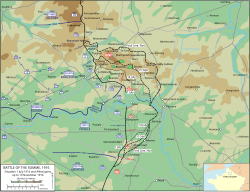| Capture of Combles | |||||||
|---|---|---|---|---|---|---|---|
| Part of The Battle of the Somme, First World War | |||||||
 Battle of the Somme 1 July – 18 November 1916 | |||||||
| |||||||
| Belligerents | |||||||
|
|
| ||||||
| Commanders and leaders | |||||||
|
Douglas Haig Joseph Joffre | Erich von Falkenhayn | ||||||
| Strength | |||||||
|
British: 2 brigades French: 1 regiment | 3 regiments | ||||||
The Capture of Combles (25 September 1916) was a tactical incident that took place during the Battle of Morval, part of the Battle of the Somme, during the First World War. Combles lies 30 mi (48 km) north-east of Amiens and 10 mi (16 km) east of Albert, on the D 20 Rancourt–Guillemont road, 8 mi (13 km) south of Bapaume, in the Combles valley a hollow between outcrops of Bazentin Ridge, between Morval to the north, Ginchy to the north-west and Falfemont Farm to the west. North of the village the valley widens into a basin, which forks north-east around the Morval Spur. In late September 1914, military operations took place in the vicinity, when the II Bavarian Corps was engaged by French Territorial divisions in an encounter battle. The French divisions were forced back and the two divisions of the II Bavarian Corps, advanced westwards on the north side of the Somme, eventually being stopped around Maricourt, Montauban and Fricourt.
Combles became a backwater until 1916, when it was used as a shelter for reserves, supplies and engineer stores and a staging area for reinforcements. Gallwitz Riegel the German third defensive position being built as the battle began, ran close behind the village. Combles was attacked by the British and French on 25 September, during the Battle of Morval after several delays due to rain and poor visibility. Brigades from the 56th and 5th divisions in the north, wheeled to the right to form a south-facing flank above Combles, as the French 2nd Division attacked from the south. The British attack swiftly established the defensive flank and patrols began to probe southwards. German resistance against the French attack close to the village, particularly with machine-gun fire, held back the advance.
Further to the east, the French captured Rancourt in the afternoon and closed up to Frégicourt. Prisoners taken by the British and French revealed that a retirement from the village was intended during the night. A constant Anglo-French artillery barrage was maintained on the exits. Infantry patrols probed forwards and the British and French forces met at several points in and east of the village in the early hours of 26 September. A huge amount of equipment, ammunition and engineering stores were captured in the village and on 27 September, the inter-army boundary was moved north to Morval, to assist French attacks towards Sailly-Saillisel. On 24 March 1918, Combles was recaptured by German troops, during the retreat of the 9th (Scottish) Division in Operation Michael, the German spring offensive. The village was recaptured for the last time on 29 August, by the 18th (Eastern) Division, during the Second Battle of Bapaume.
